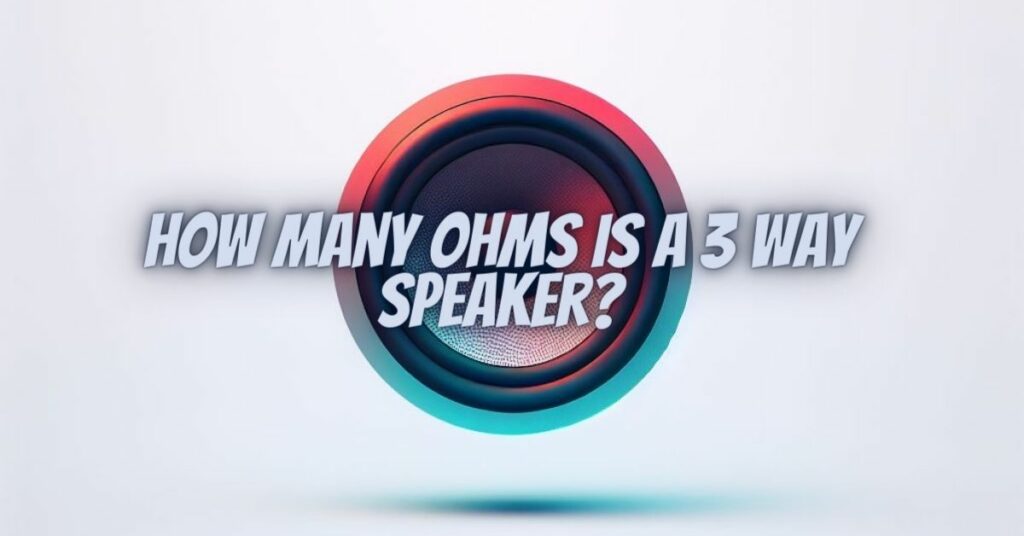When it comes to speaker systems, understanding the impedance of a 3-way speaker is essential for compatibility with amplifiers and overall sound quality. Impedance, measured in ohms, is a critical specification that influences how a speaker interacts with audio equipment. In this comprehensive article, we will explore the concept of speaker impedance, the significance of impedance in 3-way speakers, and how to choose the right amplifier for your audio system.
Understanding Speaker Impedance
Impedance, often represented in ohms (Ω), is an electrical property that measures the opposition a component presents to the flow of electrical current. In the context of speakers, impedance is crucial because it affects the way a speaker interacts with an amplifier.
Here are some essential points to understand about speaker impedance:
- Nominal Impedance: The nominal impedance of a speaker is its rated impedance, typically marked on the speaker or in its specifications. Common nominal impedance values for speakers include 4 ohms, 8 ohms, and 16 ohms.
- Dynamic Impedance: The impedance of a speaker can vary with frequency, which is why you may see impedance curves on some speaker specifications. Dynamic impedance is a more accurate representation of how a speaker behaves across the frequency spectrum.
- Amplifier Compatibility: It’s crucial to match the nominal impedance of your speakers with the compatible range of your amplifier. Using a speaker with a significantly different impedance from what your amplifier is designed for can result in poor performance, overheating, or damage to the equipment.
- Power Output: Impedance also influences the power output of your amplifier. Lower impedance speakers can draw more power from the amplifier, potentially resulting in louder sound. However, it’s essential to ensure that the amplifier can handle the lower impedance without overheating or distortion.
The Impedance of a 3-Way Speaker
A 3-way speaker is a speaker system that incorporates three main components or drivers: a woofer for handling low-frequency sounds (bass), a midrange driver for covering the mid-frequency range, and a tweeter for managing high-frequency sounds (treble). The impedance of a 3-way speaker is primarily determined by the impedance of these individual drivers and how they are wired within the speaker system.
In most cases, each driver within a 3-way speaker will have its own nominal impedance rating. These ratings can vary depending on the specific design and manufacturer of the speaker. Common impedance values for individual drivers within a 3-way speaker might include 4 ohms, 6 ohms, 8 ohms, or 16 ohms.
The overall impedance of the 3-way speaker is not simply the sum of the individual driver impedances. Instead, it is determined by a more complex calculation that takes into account how the drivers are wired together. The resulting impedance can vary, but 8 ohms is a common nominal impedance for 3-way speakers.
Choosing the Right Amplifier
When selecting an amplifier for your 3-way speakers, it’s crucial to consider the speaker’s nominal impedance and match it with the compatible range of the amplifier. Here are some key points to keep in mind:
- Matching Impedance: Choose an amplifier with an impedance range that includes the nominal impedance of your 3-way speakers. Most amplifiers can handle 8-ohm speakers, which is a common impedance rating for 3-way speakers.
- Power Compatibility: Ensure that the amplifier provides enough power to drive your speakers effectively. The power rating of the amplifier should match or exceed the speaker’s recommended power handling capabilities.
- Quality and Brand: Consider the quality and reputation of both the amplifier and the 3-way speakers. High-quality components and reputable brands often result in better sound quality and durability.
- Room Size: The size of your listening room and your intended listening volume can also influence your amplifier choice. Larger rooms may require more powerful amplifiers to fill the space with sound effectively.
In conclusion, the impedance of a 3-way speaker is determined by the individual nominal impedance ratings of its drivers and how they are wired within the speaker system. It is essential to match the nominal impedance of your 3-way speakers with the compatible range of your amplifier to ensure proper performance and prevent potential damage to your audio equipment.
Understanding the relationship between speaker impedance and amplifiers is a fundamental aspect of building an audio system that delivers optimal sound quality and reliability. By selecting the right amplifier for your 3-way speakers, you can enjoy a more immersive and enjoyable listening experience, with accurate and dynamic sound reproduction.


